Case Study on Agile Transformation
VerifiedAdded on 2022/08/08
|13
|3390
|21
AI Summary
Introduction This assignment applies your learning from the Managing People module to an organisational setting. This is an individual assignment providing you with the opportunity to demonstrate your understanding of the course materials and reflect on the application of the concepts and techniques you have studied in the module. Assignment brief Provide a very short introduction to your organisation, and your role, to provide a context for your assignment. Based on your own organisation (or part of the organisation): (a) Identify, with justification, a critical issue relating to people and how effectively they are managed within the organisation. In justifying your chosen issue, you should analyse the organisational context using the module materials to show how the issue has arisen and the impact that it has. (40% of the marks)
Contribute Materials
Your contribution can guide someone’s learning journey. Share your
documents today.
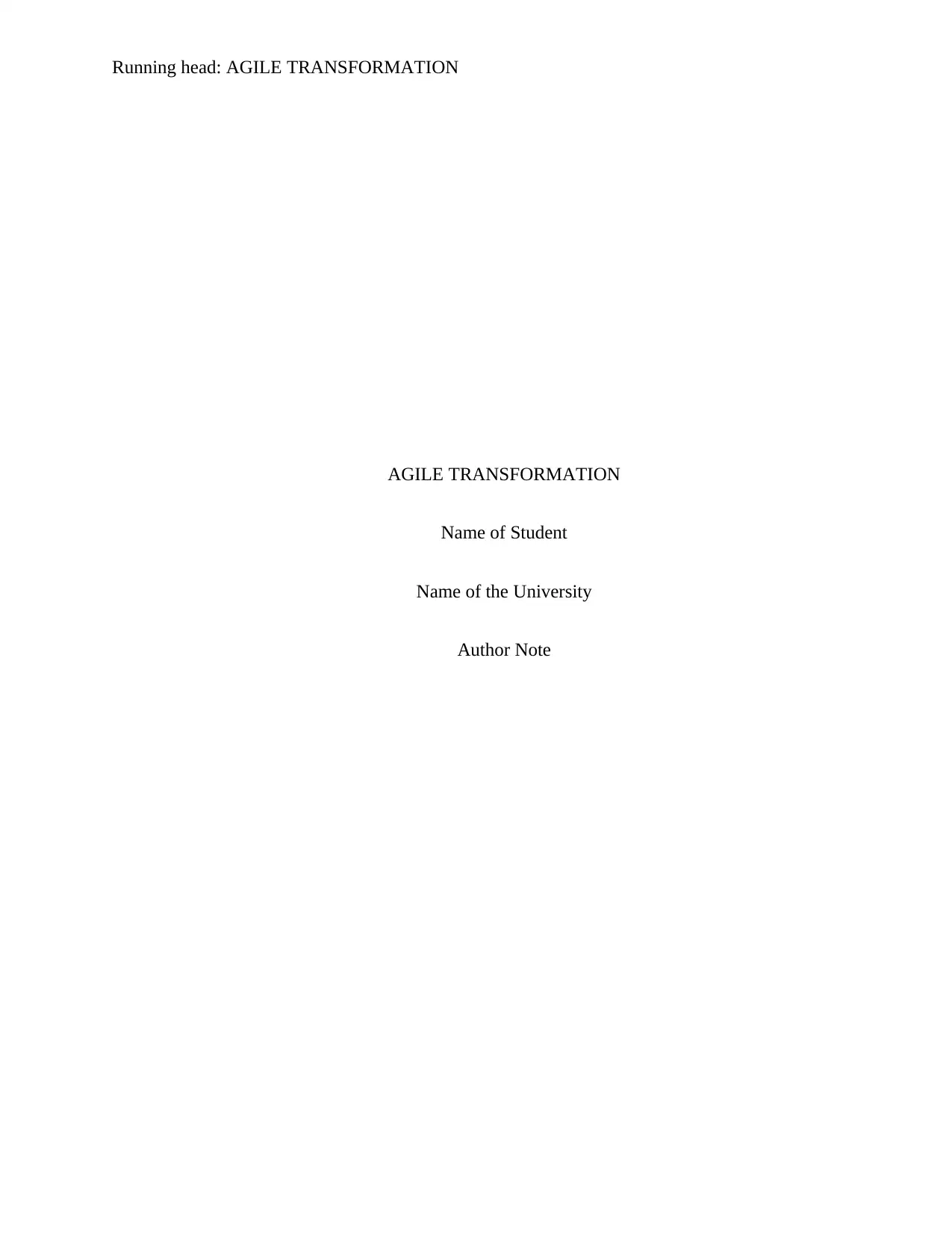
Running head: AGILE TRANSFORMATION
AGILE TRANSFORMATION
Name of Student
Name of the University
Author Note
AGILE TRANSFORMATION
Name of Student
Name of the University
Author Note
Secure Best Marks with AI Grader
Need help grading? Try our AI Grader for instant feedback on your assignments.
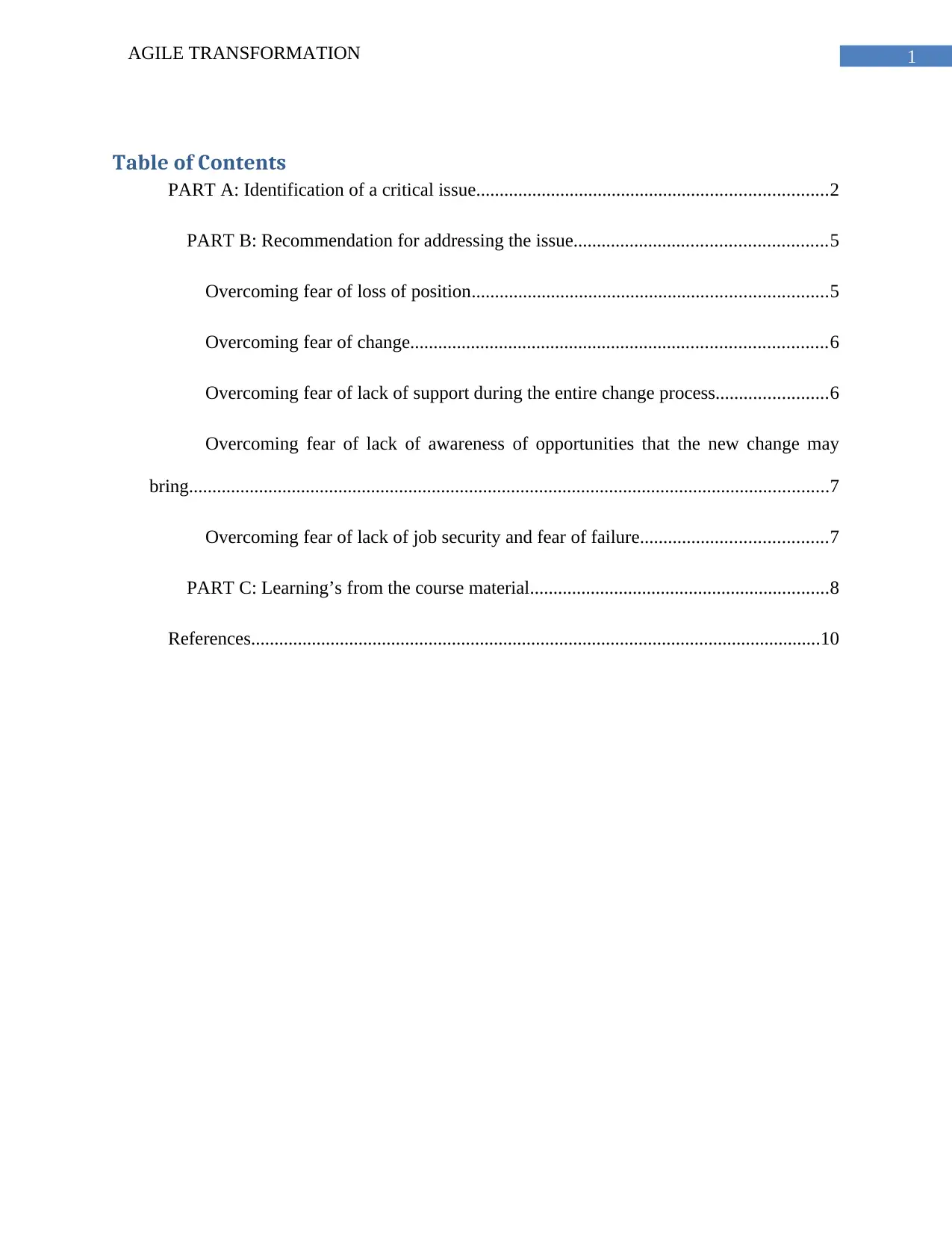
1AGILE TRANSFORMATION
Table of Contents
PART A: Identification of a critical issue...........................................................................2
PART B: Recommendation for addressing the issue......................................................5
Overcoming fear of loss of position............................................................................5
Overcoming fear of change.........................................................................................6
Overcoming fear of lack of support during the entire change process........................6
Overcoming fear of lack of awareness of opportunities that the new change may
bring.........................................................................................................................................7
Overcoming fear of lack of job security and fear of failure........................................7
PART C: Learning’s from the course material................................................................8
References..........................................................................................................................10
Table of Contents
PART A: Identification of a critical issue...........................................................................2
PART B: Recommendation for addressing the issue......................................................5
Overcoming fear of loss of position............................................................................5
Overcoming fear of change.........................................................................................6
Overcoming fear of lack of support during the entire change process........................6
Overcoming fear of lack of awareness of opportunities that the new change may
bring.........................................................................................................................................7
Overcoming fear of lack of job security and fear of failure........................................7
PART C: Learning’s from the course material................................................................8
References..........................................................................................................................10
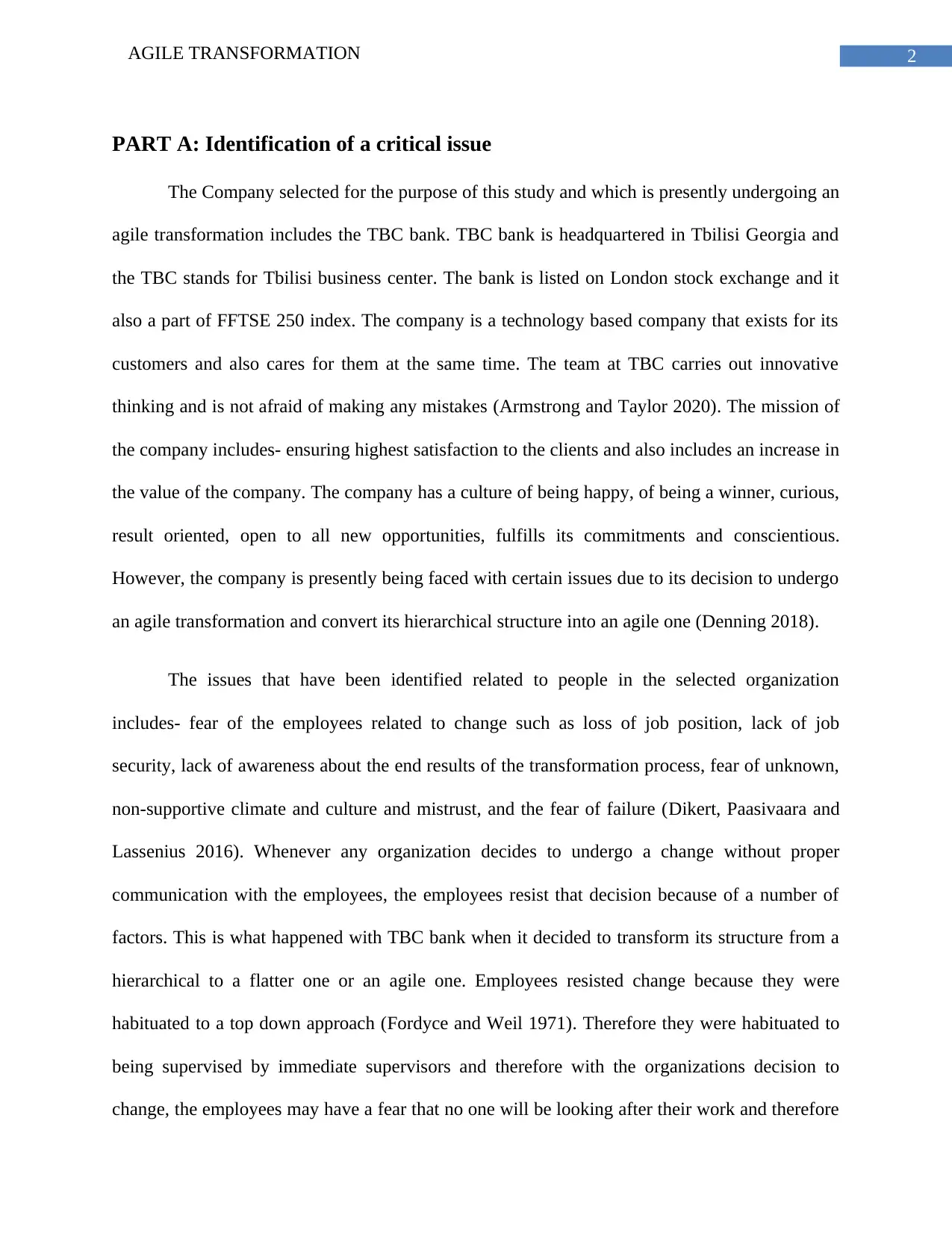
2AGILE TRANSFORMATION
PART A: Identification of a critical issue
The Company selected for the purpose of this study and which is presently undergoing an
agile transformation includes the TBC bank. TBC bank is headquartered in Tbilisi Georgia and
the TBC stands for Tbilisi business center. The bank is listed on London stock exchange and it
also a part of FFTSE 250 index. The company is a technology based company that exists for its
customers and also cares for them at the same time. The team at TBC carries out innovative
thinking and is not afraid of making any mistakes (Armstrong and Taylor 2020). The mission of
the company includes- ensuring highest satisfaction to the clients and also includes an increase in
the value of the company. The company has a culture of being happy, of being a winner, curious,
result oriented, open to all new opportunities, fulfills its commitments and conscientious.
However, the company is presently being faced with certain issues due to its decision to undergo
an agile transformation and convert its hierarchical structure into an agile one (Denning 2018).
The issues that have been identified related to people in the selected organization
includes- fear of the employees related to change such as loss of job position, lack of job
security, lack of awareness about the end results of the transformation process, fear of unknown,
non-supportive climate and culture and mistrust, and the fear of failure (Dikert, Paasivaara and
Lassenius 2016). Whenever any organization decides to undergo a change without proper
communication with the employees, the employees resist that decision because of a number of
factors. This is what happened with TBC bank when it decided to transform its structure from a
hierarchical to a flatter one or an agile one. Employees resisted change because they were
habituated to a top down approach (Fordyce and Weil 1971). Therefore they were habituated to
being supervised by immediate supervisors and therefore with the organizations decision to
change, the employees may have a fear that no one will be looking after their work and therefore
PART A: Identification of a critical issue
The Company selected for the purpose of this study and which is presently undergoing an
agile transformation includes the TBC bank. TBC bank is headquartered in Tbilisi Georgia and
the TBC stands for Tbilisi business center. The bank is listed on London stock exchange and it
also a part of FFTSE 250 index. The company is a technology based company that exists for its
customers and also cares for them at the same time. The team at TBC carries out innovative
thinking and is not afraid of making any mistakes (Armstrong and Taylor 2020). The mission of
the company includes- ensuring highest satisfaction to the clients and also includes an increase in
the value of the company. The company has a culture of being happy, of being a winner, curious,
result oriented, open to all new opportunities, fulfills its commitments and conscientious.
However, the company is presently being faced with certain issues due to its decision to undergo
an agile transformation and convert its hierarchical structure into an agile one (Denning 2018).
The issues that have been identified related to people in the selected organization
includes- fear of the employees related to change such as loss of job position, lack of job
security, lack of awareness about the end results of the transformation process, fear of unknown,
non-supportive climate and culture and mistrust, and the fear of failure (Dikert, Paasivaara and
Lassenius 2016). Whenever any organization decides to undergo a change without proper
communication with the employees, the employees resist that decision because of a number of
factors. This is what happened with TBC bank when it decided to transform its structure from a
hierarchical to a flatter one or an agile one. Employees resisted change because they were
habituated to a top down approach (Fordyce and Weil 1971). Therefore they were habituated to
being supervised by immediate supervisors and therefore with the organizations decision to
change, the employees may have a fear that no one will be looking after their work and therefore
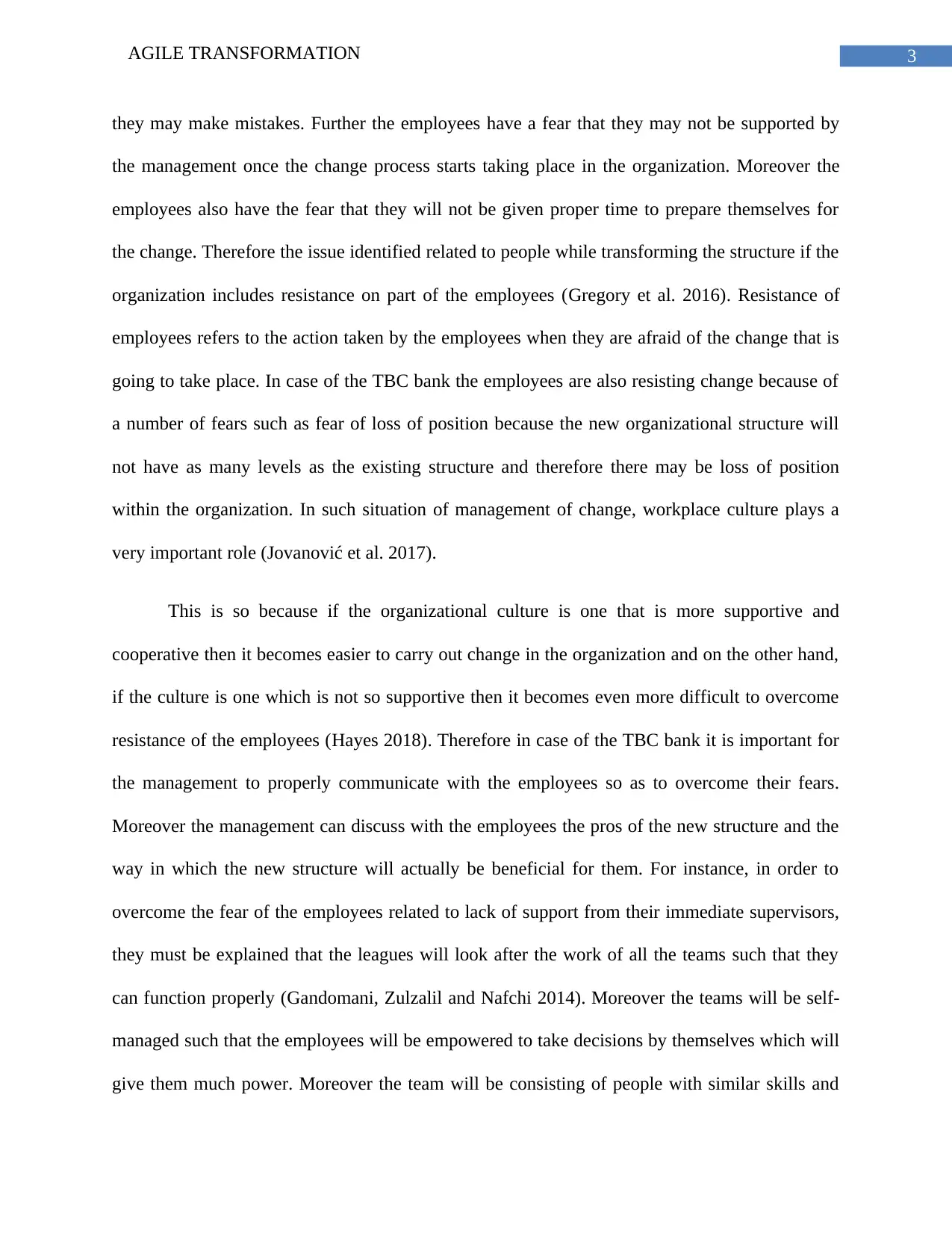
3AGILE TRANSFORMATION
they may make mistakes. Further the employees have a fear that they may not be supported by
the management once the change process starts taking place in the organization. Moreover the
employees also have the fear that they will not be given proper time to prepare themselves for
the change. Therefore the issue identified related to people while transforming the structure if the
organization includes resistance on part of the employees (Gregory et al. 2016). Resistance of
employees refers to the action taken by the employees when they are afraid of the change that is
going to take place. In case of the TBC bank the employees are also resisting change because of
a number of fears such as fear of loss of position because the new organizational structure will
not have as many levels as the existing structure and therefore there may be loss of position
within the organization. In such situation of management of change, workplace culture plays a
very important role (Jovanović et al. 2017).
This is so because if the organizational culture is one that is more supportive and
cooperative then it becomes easier to carry out change in the organization and on the other hand,
if the culture is one which is not so supportive then it becomes even more difficult to overcome
resistance of the employees (Hayes 2018). Therefore in case of the TBC bank it is important for
the management to properly communicate with the employees so as to overcome their fears.
Moreover the management can discuss with the employees the pros of the new structure and the
way in which the new structure will actually be beneficial for them. For instance, in order to
overcome the fear of the employees related to lack of support from their immediate supervisors,
they must be explained that the leagues will look after the work of all the teams such that they
can function properly (Gandomani, Zulzalil and Nafchi 2014). Moreover the teams will be self-
managed such that the employees will be empowered to take decisions by themselves which will
give them much power. Moreover the team will be consisting of people with similar skills and
they may make mistakes. Further the employees have a fear that they may not be supported by
the management once the change process starts taking place in the organization. Moreover the
employees also have the fear that they will not be given proper time to prepare themselves for
the change. Therefore the issue identified related to people while transforming the structure if the
organization includes resistance on part of the employees (Gregory et al. 2016). Resistance of
employees refers to the action taken by the employees when they are afraid of the change that is
going to take place. In case of the TBC bank the employees are also resisting change because of
a number of fears such as fear of loss of position because the new organizational structure will
not have as many levels as the existing structure and therefore there may be loss of position
within the organization. In such situation of management of change, workplace culture plays a
very important role (Jovanović et al. 2017).
This is so because if the organizational culture is one that is more supportive and
cooperative then it becomes easier to carry out change in the organization and on the other hand,
if the culture is one which is not so supportive then it becomes even more difficult to overcome
resistance of the employees (Hayes 2018). Therefore in case of the TBC bank it is important for
the management to properly communicate with the employees so as to overcome their fears.
Moreover the management can discuss with the employees the pros of the new structure and the
way in which the new structure will actually be beneficial for them. For instance, in order to
overcome the fear of the employees related to lack of support from their immediate supervisors,
they must be explained that the leagues will look after the work of all the teams such that they
can function properly (Gandomani, Zulzalil and Nafchi 2014). Moreover the teams will be self-
managed such that the employees will be empowered to take decisions by themselves which will
give them much power. Moreover the team will be consisting of people with similar skills and
Secure Best Marks with AI Grader
Need help grading? Try our AI Grader for instant feedback on your assignments.
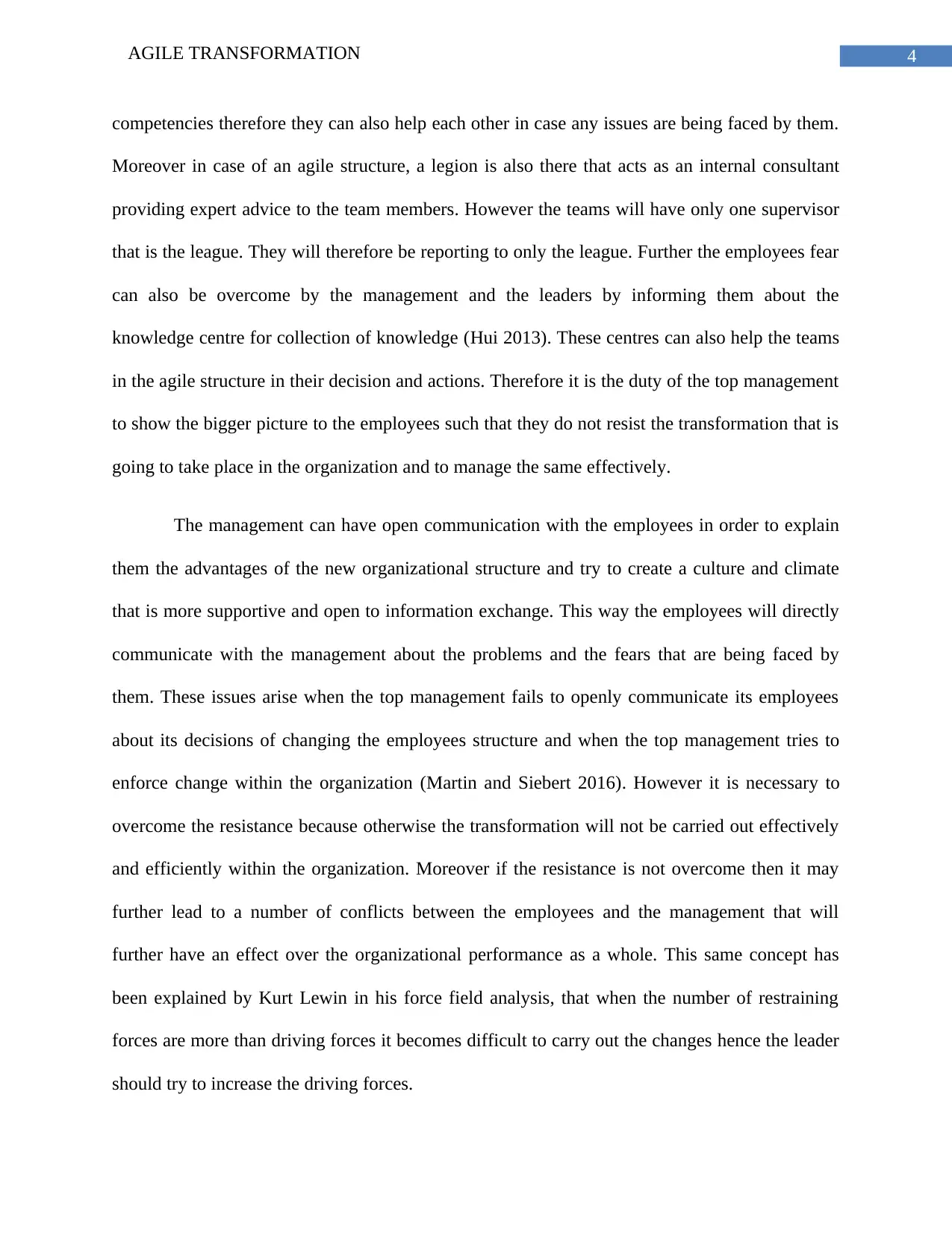
4AGILE TRANSFORMATION
competencies therefore they can also help each other in case any issues are being faced by them.
Moreover in case of an agile structure, a legion is also there that acts as an internal consultant
providing expert advice to the team members. However the teams will have only one supervisor
that is the league. They will therefore be reporting to only the league. Further the employees fear
can also be overcome by the management and the leaders by informing them about the
knowledge centre for collection of knowledge (Hui 2013). These centres can also help the teams
in the agile structure in their decision and actions. Therefore it is the duty of the top management
to show the bigger picture to the employees such that they do not resist the transformation that is
going to take place in the organization and to manage the same effectively.
The management can have open communication with the employees in order to explain
them the advantages of the new organizational structure and try to create a culture and climate
that is more supportive and open to information exchange. This way the employees will directly
communicate with the management about the problems and the fears that are being faced by
them. These issues arise when the top management fails to openly communicate its employees
about its decisions of changing the employees structure and when the top management tries to
enforce change within the organization (Martin and Siebert 2016). However it is necessary to
overcome the resistance because otherwise the transformation will not be carried out effectively
and efficiently within the organization. Moreover if the resistance is not overcome then it may
further lead to a number of conflicts between the employees and the management that will
further have an effect over the organizational performance as a whole. This same concept has
been explained by Kurt Lewin in his force field analysis, that when the number of restraining
forces are more than driving forces it becomes difficult to carry out the changes hence the leader
should try to increase the driving forces.
competencies therefore they can also help each other in case any issues are being faced by them.
Moreover in case of an agile structure, a legion is also there that acts as an internal consultant
providing expert advice to the team members. However the teams will have only one supervisor
that is the league. They will therefore be reporting to only the league. Further the employees fear
can also be overcome by the management and the leaders by informing them about the
knowledge centre for collection of knowledge (Hui 2013). These centres can also help the teams
in the agile structure in their decision and actions. Therefore it is the duty of the top management
to show the bigger picture to the employees such that they do not resist the transformation that is
going to take place in the organization and to manage the same effectively.
The management can have open communication with the employees in order to explain
them the advantages of the new organizational structure and try to create a culture and climate
that is more supportive and open to information exchange. This way the employees will directly
communicate with the management about the problems and the fears that are being faced by
them. These issues arise when the top management fails to openly communicate its employees
about its decisions of changing the employees structure and when the top management tries to
enforce change within the organization (Martin and Siebert 2016). However it is necessary to
overcome the resistance because otherwise the transformation will not be carried out effectively
and efficiently within the organization. Moreover if the resistance is not overcome then it may
further lead to a number of conflicts between the employees and the management that will
further have an effect over the organizational performance as a whole. This same concept has
been explained by Kurt Lewin in his force field analysis, that when the number of restraining
forces are more than driving forces it becomes difficult to carry out the changes hence the leader
should try to increase the driving forces.
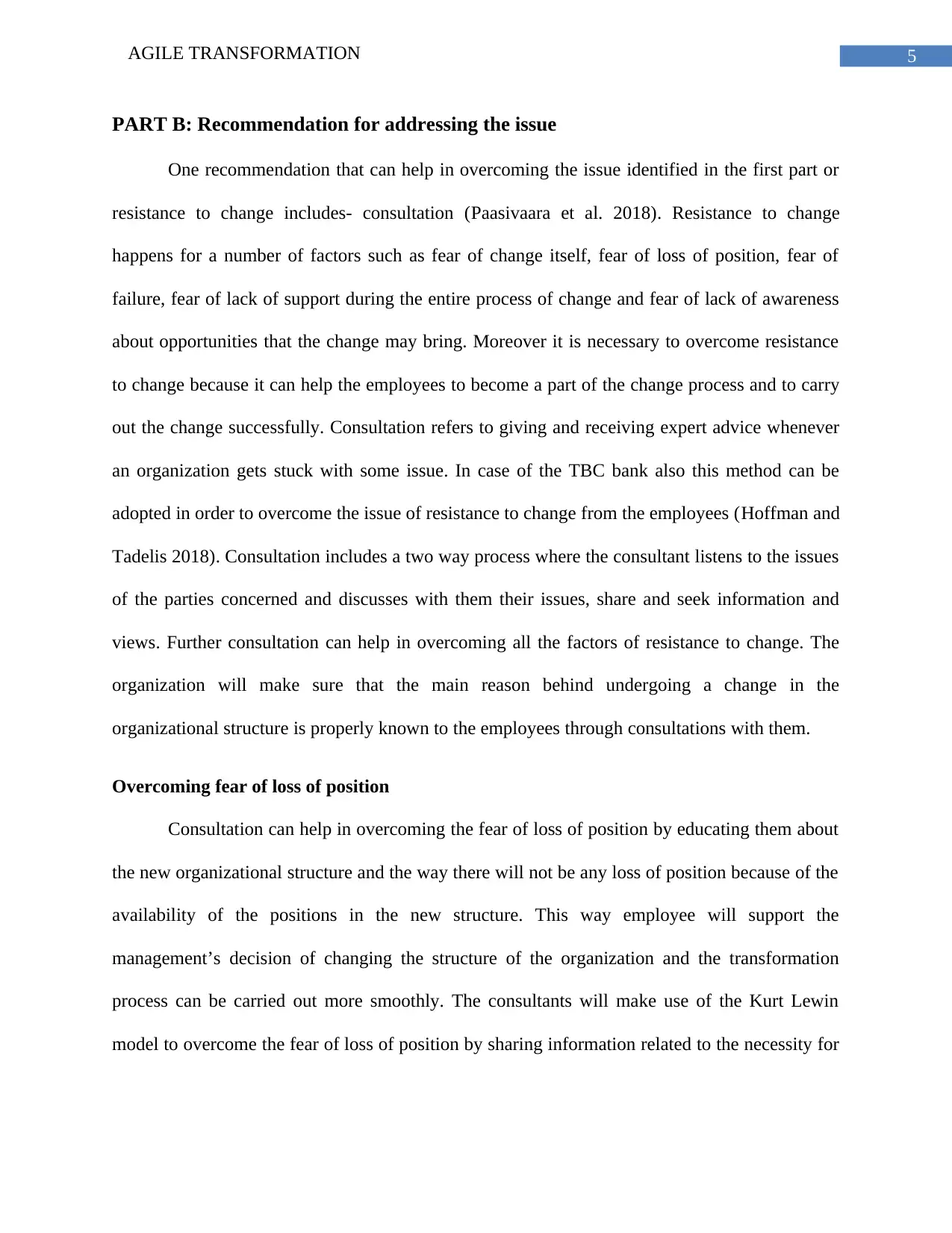
5AGILE TRANSFORMATION
PART B: Recommendation for addressing the issue
One recommendation that can help in overcoming the issue identified in the first part or
resistance to change includes- consultation (Paasivaara et al. 2018). Resistance to change
happens for a number of factors such as fear of change itself, fear of loss of position, fear of
failure, fear of lack of support during the entire process of change and fear of lack of awareness
about opportunities that the change may bring. Moreover it is necessary to overcome resistance
to change because it can help the employees to become a part of the change process and to carry
out the change successfully. Consultation refers to giving and receiving expert advice whenever
an organization gets stuck with some issue. In case of the TBC bank also this method can be
adopted in order to overcome the issue of resistance to change from the employees (Hoffman and
Tadelis 2018). Consultation includes a two way process where the consultant listens to the issues
of the parties concerned and discusses with them their issues, share and seek information and
views. Further consultation can help in overcoming all the factors of resistance to change. The
organization will make sure that the main reason behind undergoing a change in the
organizational structure is properly known to the employees through consultations with them.
Overcoming fear of loss of position
Consultation can help in overcoming the fear of loss of position by educating them about
the new organizational structure and the way there will not be any loss of position because of the
availability of the positions in the new structure. This way employee will support the
management’s decision of changing the structure of the organization and the transformation
process can be carried out more smoothly. The consultants will make use of the Kurt Lewin
model to overcome the fear of loss of position by sharing information related to the necessity for
PART B: Recommendation for addressing the issue
One recommendation that can help in overcoming the issue identified in the first part or
resistance to change includes- consultation (Paasivaara et al. 2018). Resistance to change
happens for a number of factors such as fear of change itself, fear of loss of position, fear of
failure, fear of lack of support during the entire process of change and fear of lack of awareness
about opportunities that the change may bring. Moreover it is necessary to overcome resistance
to change because it can help the employees to become a part of the change process and to carry
out the change successfully. Consultation refers to giving and receiving expert advice whenever
an organization gets stuck with some issue. In case of the TBC bank also this method can be
adopted in order to overcome the issue of resistance to change from the employees (Hoffman and
Tadelis 2018). Consultation includes a two way process where the consultant listens to the issues
of the parties concerned and discusses with them their issues, share and seek information and
views. Further consultation can help in overcoming all the factors of resistance to change. The
organization will make sure that the main reason behind undergoing a change in the
organizational structure is properly known to the employees through consultations with them.
Overcoming fear of loss of position
Consultation can help in overcoming the fear of loss of position by educating them about
the new organizational structure and the way there will not be any loss of position because of the
availability of the positions in the new structure. This way employee will support the
management’s decision of changing the structure of the organization and the transformation
process can be carried out more smoothly. The consultants will make use of the Kurt Lewin
model to overcome the fear of loss of position by sharing information related to the necessity for
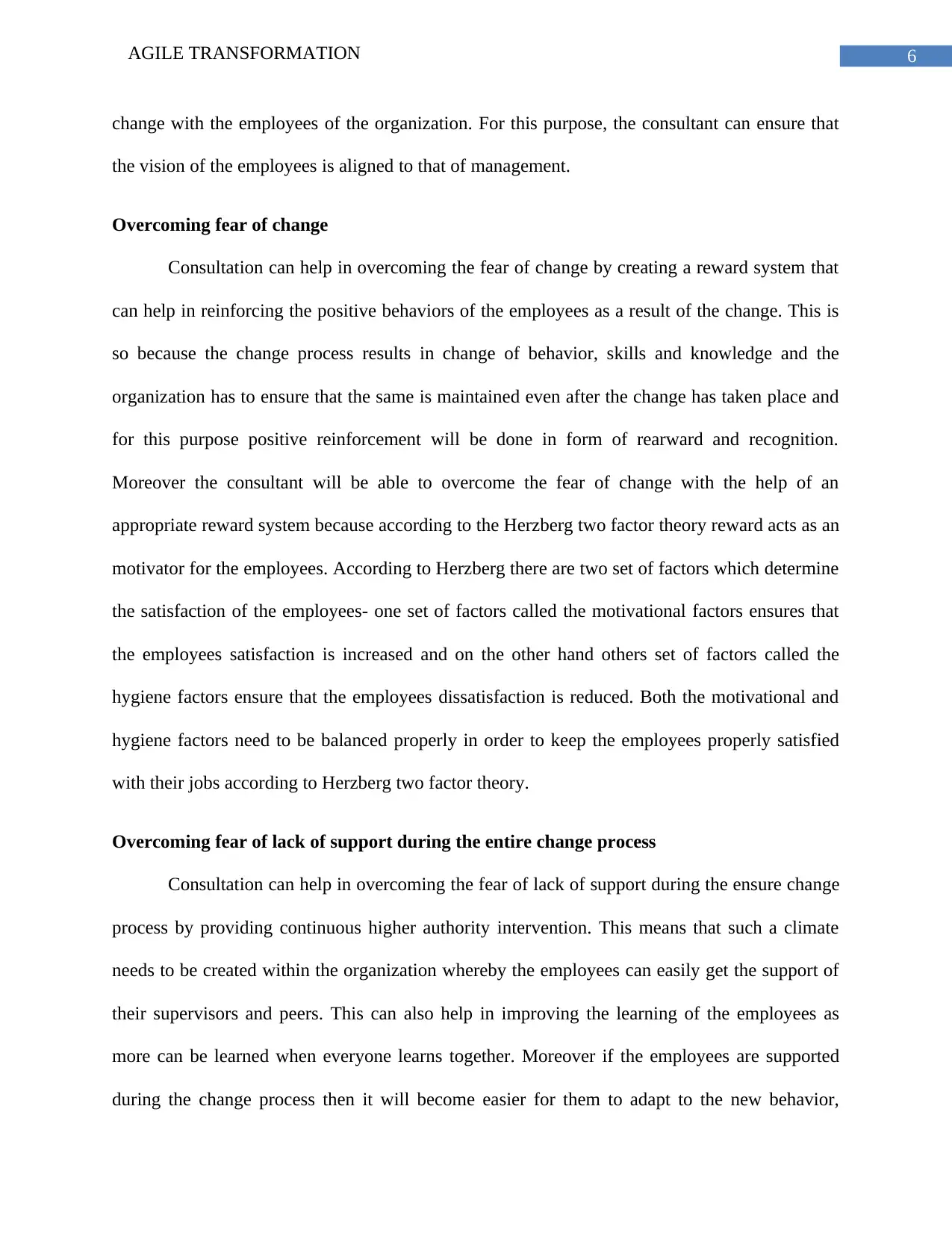
6AGILE TRANSFORMATION
change with the employees of the organization. For this purpose, the consultant can ensure that
the vision of the employees is aligned to that of management.
Overcoming fear of change
Consultation can help in overcoming the fear of change by creating a reward system that
can help in reinforcing the positive behaviors of the employees as a result of the change. This is
so because the change process results in change of behavior, skills and knowledge and the
organization has to ensure that the same is maintained even after the change has taken place and
for this purpose positive reinforcement will be done in form of rearward and recognition.
Moreover the consultant will be able to overcome the fear of change with the help of an
appropriate reward system because according to the Herzberg two factor theory reward acts as an
motivator for the employees. According to Herzberg there are two set of factors which determine
the satisfaction of the employees- one set of factors called the motivational factors ensures that
the employees satisfaction is increased and on the other hand others set of factors called the
hygiene factors ensure that the employees dissatisfaction is reduced. Both the motivational and
hygiene factors need to be balanced properly in order to keep the employees properly satisfied
with their jobs according to Herzberg two factor theory.
Overcoming fear of lack of support during the entire change process
Consultation can help in overcoming the fear of lack of support during the ensure change
process by providing continuous higher authority intervention. This means that such a climate
needs to be created within the organization whereby the employees can easily get the support of
their supervisors and peers. This can also help in improving the learning of the employees as
more can be learned when everyone learns together. Moreover if the employees are supported
during the change process then it will become easier for them to adapt to the new behavior,
change with the employees of the organization. For this purpose, the consultant can ensure that
the vision of the employees is aligned to that of management.
Overcoming fear of change
Consultation can help in overcoming the fear of change by creating a reward system that
can help in reinforcing the positive behaviors of the employees as a result of the change. This is
so because the change process results in change of behavior, skills and knowledge and the
organization has to ensure that the same is maintained even after the change has taken place and
for this purpose positive reinforcement will be done in form of rearward and recognition.
Moreover the consultant will be able to overcome the fear of change with the help of an
appropriate reward system because according to the Herzberg two factor theory reward acts as an
motivator for the employees. According to Herzberg there are two set of factors which determine
the satisfaction of the employees- one set of factors called the motivational factors ensures that
the employees satisfaction is increased and on the other hand others set of factors called the
hygiene factors ensure that the employees dissatisfaction is reduced. Both the motivational and
hygiene factors need to be balanced properly in order to keep the employees properly satisfied
with their jobs according to Herzberg two factor theory.
Overcoming fear of lack of support during the entire change process
Consultation can help in overcoming the fear of lack of support during the ensure change
process by providing continuous higher authority intervention. This means that such a climate
needs to be created within the organization whereby the employees can easily get the support of
their supervisors and peers. This can also help in improving the learning of the employees as
more can be learned when everyone learns together. Moreover if the employees are supported
during the change process then it will become easier for them to adapt to the new behavior,
Paraphrase This Document
Need a fresh take? Get an instant paraphrase of this document with our AI Paraphraser
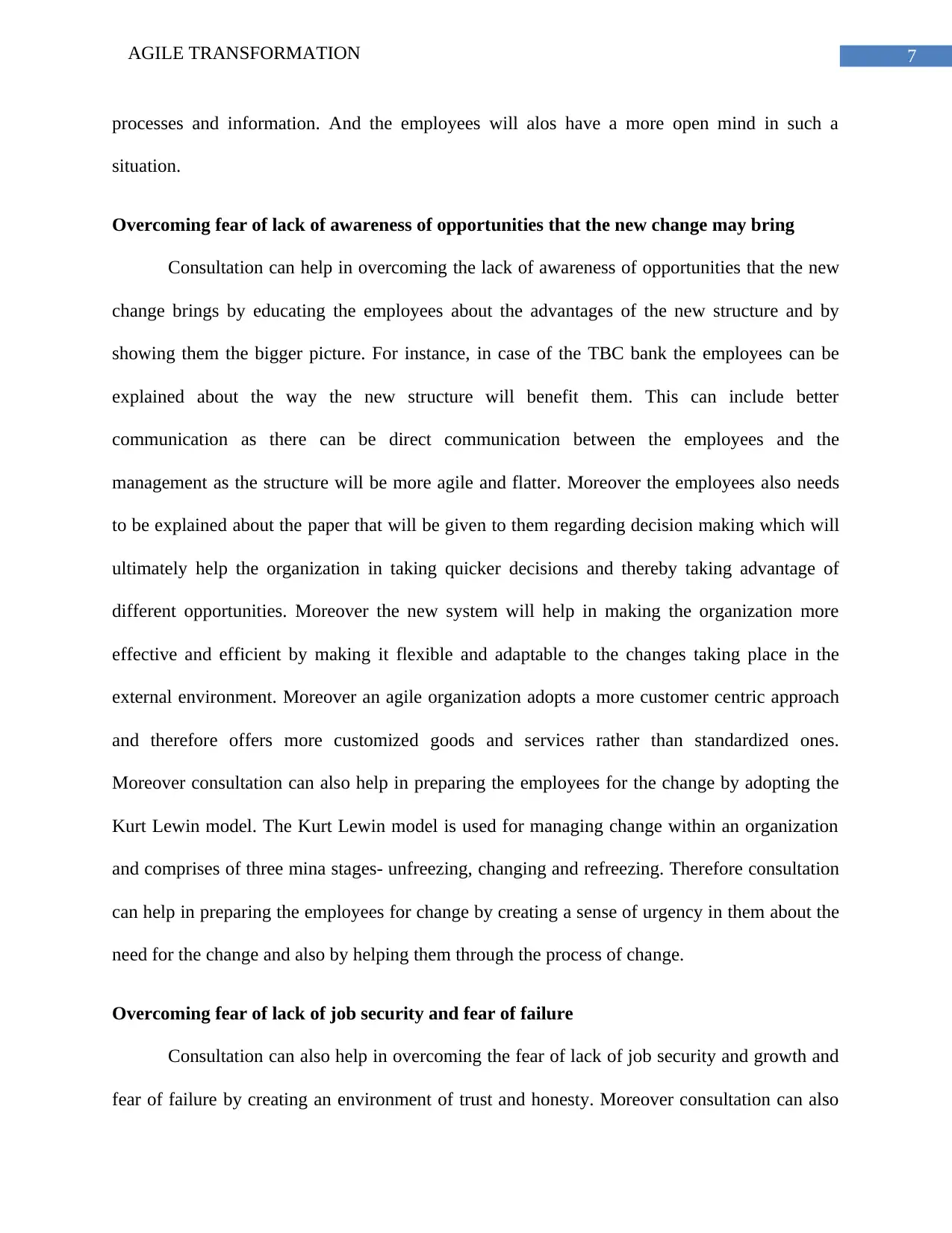
7AGILE TRANSFORMATION
processes and information. And the employees will alos have a more open mind in such a
situation.
Overcoming fear of lack of awareness of opportunities that the new change may bring
Consultation can help in overcoming the lack of awareness of opportunities that the new
change brings by educating the employees about the advantages of the new structure and by
showing them the bigger picture. For instance, in case of the TBC bank the employees can be
explained about the way the new structure will benefit them. This can include better
communication as there can be direct communication between the employees and the
management as the structure will be more agile and flatter. Moreover the employees also needs
to be explained about the paper that will be given to them regarding decision making which will
ultimately help the organization in taking quicker decisions and thereby taking advantage of
different opportunities. Moreover the new system will help in making the organization more
effective and efficient by making it flexible and adaptable to the changes taking place in the
external environment. Moreover an agile organization adopts a more customer centric approach
and therefore offers more customized goods and services rather than standardized ones.
Moreover consultation can also help in preparing the employees for the change by adopting the
Kurt Lewin model. The Kurt Lewin model is used for managing change within an organization
and comprises of three mina stages- unfreezing, changing and refreezing. Therefore consultation
can help in preparing the employees for change by creating a sense of urgency in them about the
need for the change and also by helping them through the process of change.
Overcoming fear of lack of job security and fear of failure
Consultation can also help in overcoming the fear of lack of job security and growth and
fear of failure by creating an environment of trust and honesty. Moreover consultation can also
processes and information. And the employees will alos have a more open mind in such a
situation.
Overcoming fear of lack of awareness of opportunities that the new change may bring
Consultation can help in overcoming the lack of awareness of opportunities that the new
change brings by educating the employees about the advantages of the new structure and by
showing them the bigger picture. For instance, in case of the TBC bank the employees can be
explained about the way the new structure will benefit them. This can include better
communication as there can be direct communication between the employees and the
management as the structure will be more agile and flatter. Moreover the employees also needs
to be explained about the paper that will be given to them regarding decision making which will
ultimately help the organization in taking quicker decisions and thereby taking advantage of
different opportunities. Moreover the new system will help in making the organization more
effective and efficient by making it flexible and adaptable to the changes taking place in the
external environment. Moreover an agile organization adopts a more customer centric approach
and therefore offers more customized goods and services rather than standardized ones.
Moreover consultation can also help in preparing the employees for the change by adopting the
Kurt Lewin model. The Kurt Lewin model is used for managing change within an organization
and comprises of three mina stages- unfreezing, changing and refreezing. Therefore consultation
can help in preparing the employees for change by creating a sense of urgency in them about the
need for the change and also by helping them through the process of change.
Overcoming fear of lack of job security and fear of failure
Consultation can also help in overcoming the fear of lack of job security and growth and
fear of failure by creating an environment of trust and honesty. Moreover consultation can also
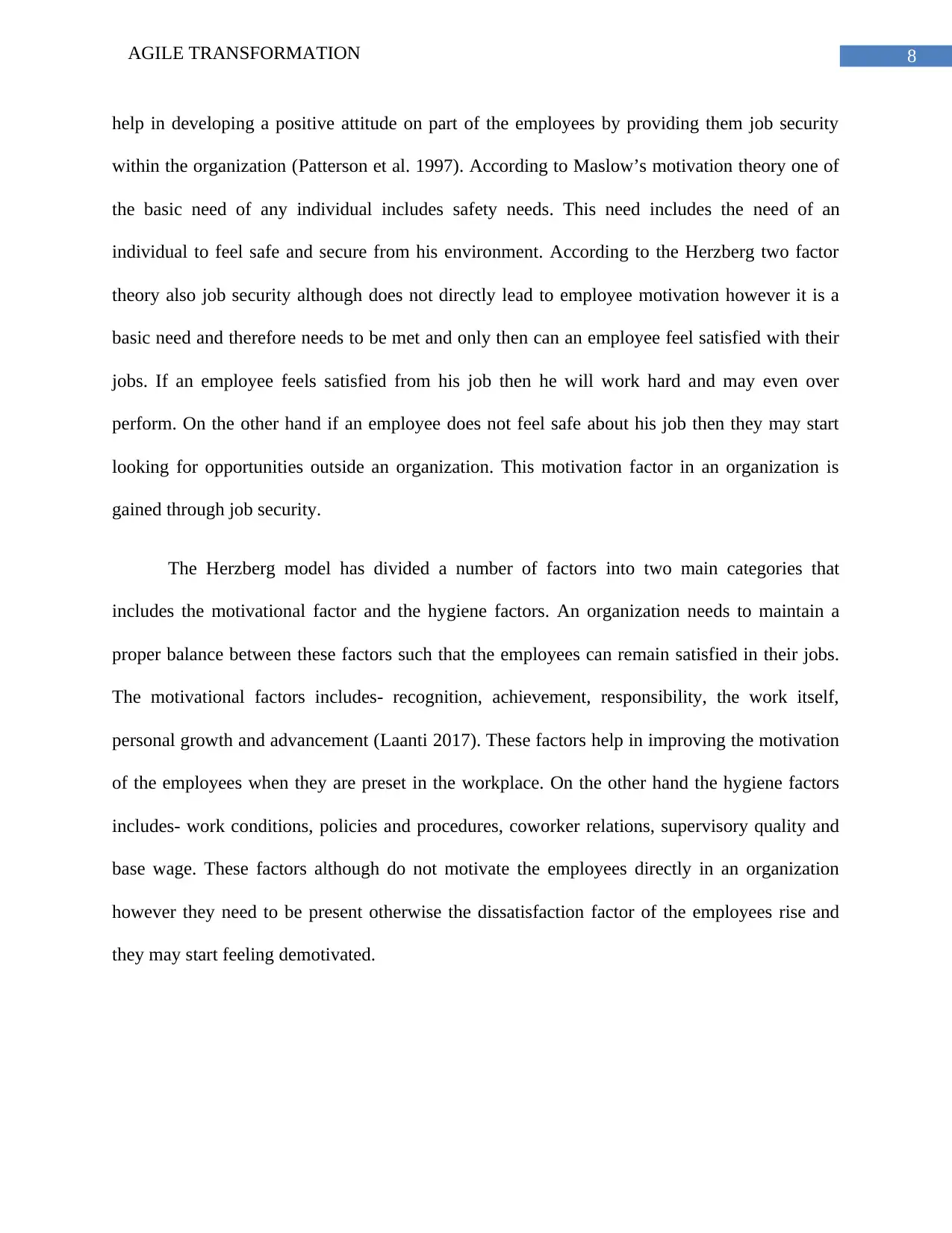
8AGILE TRANSFORMATION
help in developing a positive attitude on part of the employees by providing them job security
within the organization (Patterson et al. 1997). According to Maslow’s motivation theory one of
the basic need of any individual includes safety needs. This need includes the need of an
individual to feel safe and secure from his environment. According to the Herzberg two factor
theory also job security although does not directly lead to employee motivation however it is a
basic need and therefore needs to be met and only then can an employee feel satisfied with their
jobs. If an employee feels satisfied from his job then he will work hard and may even over
perform. On the other hand if an employee does not feel safe about his job then they may start
looking for opportunities outside an organization. This motivation factor in an organization is
gained through job security.
The Herzberg model has divided a number of factors into two main categories that
includes the motivational factor and the hygiene factors. An organization needs to maintain a
proper balance between these factors such that the employees can remain satisfied in their jobs.
The motivational factors includes- recognition, achievement, responsibility, the work itself,
personal growth and advancement (Laanti 2017). These factors help in improving the motivation
of the employees when they are preset in the workplace. On the other hand the hygiene factors
includes- work conditions, policies and procedures, coworker relations, supervisory quality and
base wage. These factors although do not motivate the employees directly in an organization
however they need to be present otherwise the dissatisfaction factor of the employees rise and
they may start feeling demotivated.
help in developing a positive attitude on part of the employees by providing them job security
within the organization (Patterson et al. 1997). According to Maslow’s motivation theory one of
the basic need of any individual includes safety needs. This need includes the need of an
individual to feel safe and secure from his environment. According to the Herzberg two factor
theory also job security although does not directly lead to employee motivation however it is a
basic need and therefore needs to be met and only then can an employee feel satisfied with their
jobs. If an employee feels satisfied from his job then he will work hard and may even over
perform. On the other hand if an employee does not feel safe about his job then they may start
looking for opportunities outside an organization. This motivation factor in an organization is
gained through job security.
The Herzberg model has divided a number of factors into two main categories that
includes the motivational factor and the hygiene factors. An organization needs to maintain a
proper balance between these factors such that the employees can remain satisfied in their jobs.
The motivational factors includes- recognition, achievement, responsibility, the work itself,
personal growth and advancement (Laanti 2017). These factors help in improving the motivation
of the employees when they are preset in the workplace. On the other hand the hygiene factors
includes- work conditions, policies and procedures, coworker relations, supervisory quality and
base wage. These factors although do not motivate the employees directly in an organization
however they need to be present otherwise the dissatisfaction factor of the employees rise and
they may start feeling demotivated.
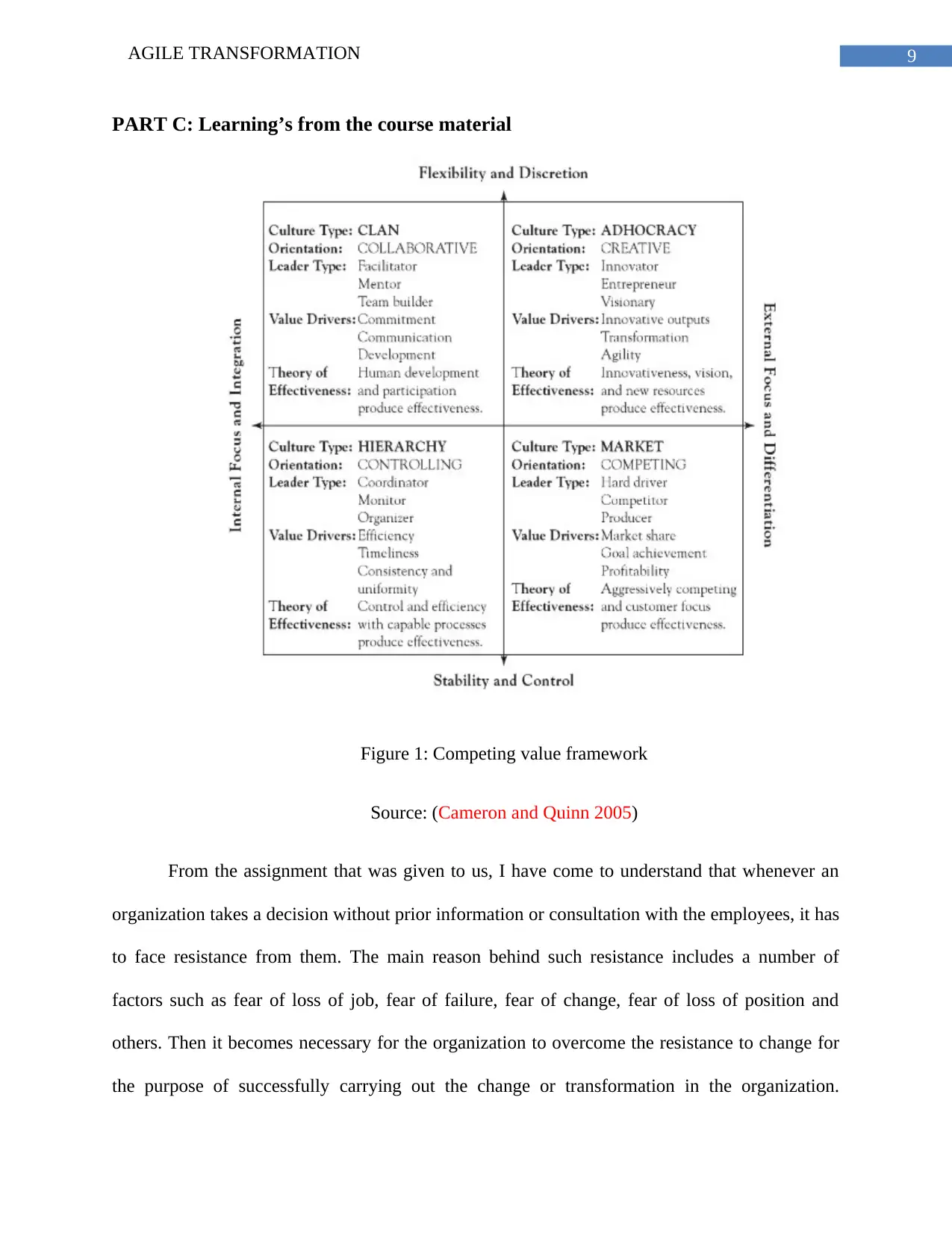
9AGILE TRANSFORMATION
PART C: Learning’s from the course material
Figure 1: Competing value framework
Source: (Cameron and Quinn 2005)
From the assignment that was given to us, I have come to understand that whenever an
organization takes a decision without prior information or consultation with the employees, it has
to face resistance from them. The main reason behind such resistance includes a number of
factors such as fear of loss of job, fear of failure, fear of change, fear of loss of position and
others. Then it becomes necessary for the organization to overcome the resistance to change for
the purpose of successfully carrying out the change or transformation in the organization.
PART C: Learning’s from the course material
Figure 1: Competing value framework
Source: (Cameron and Quinn 2005)
From the assignment that was given to us, I have come to understand that whenever an
organization takes a decision without prior information or consultation with the employees, it has
to face resistance from them. The main reason behind such resistance includes a number of
factors such as fear of loss of job, fear of failure, fear of change, fear of loss of position and
others. Then it becomes necessary for the organization to overcome the resistance to change for
the purpose of successfully carrying out the change or transformation in the organization.
Secure Best Marks with AI Grader
Need help grading? Try our AI Grader for instant feedback on your assignments.
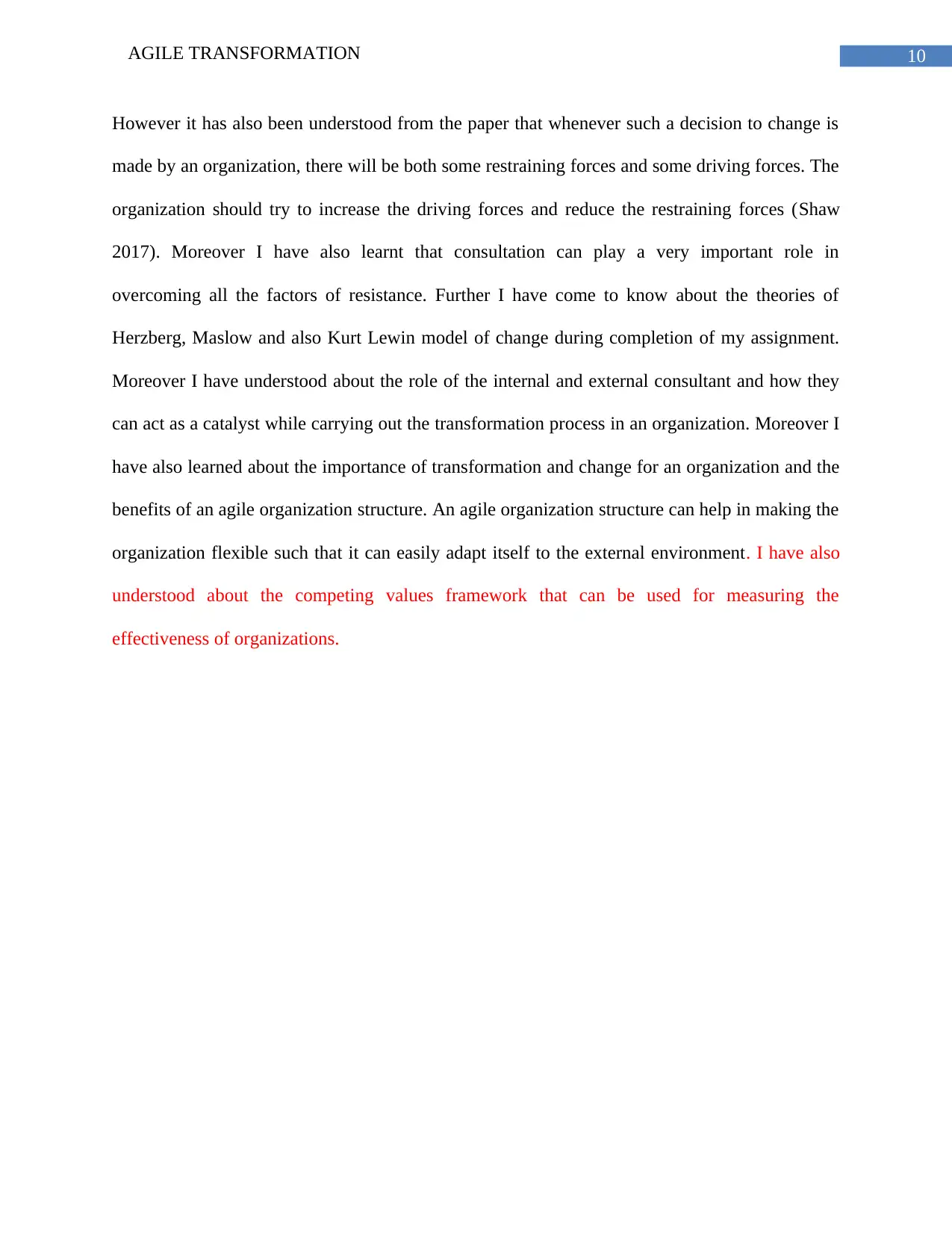
10AGILE TRANSFORMATION
However it has also been understood from the paper that whenever such a decision to change is
made by an organization, there will be both some restraining forces and some driving forces. The
organization should try to increase the driving forces and reduce the restraining forces (Shaw
2017). Moreover I have also learnt that consultation can play a very important role in
overcoming all the factors of resistance. Further I have come to know about the theories of
Herzberg, Maslow and also Kurt Lewin model of change during completion of my assignment.
Moreover I have understood about the role of the internal and external consultant and how they
can act as a catalyst while carrying out the transformation process in an organization. Moreover I
have also learned about the importance of transformation and change for an organization and the
benefits of an agile organization structure. An agile organization structure can help in making the
organization flexible such that it can easily adapt itself to the external environment. I have also
understood about the competing values framework that can be used for measuring the
effectiveness of organizations.
However it has also been understood from the paper that whenever such a decision to change is
made by an organization, there will be both some restraining forces and some driving forces. The
organization should try to increase the driving forces and reduce the restraining forces (Shaw
2017). Moreover I have also learnt that consultation can play a very important role in
overcoming all the factors of resistance. Further I have come to know about the theories of
Herzberg, Maslow and also Kurt Lewin model of change during completion of my assignment.
Moreover I have understood about the role of the internal and external consultant and how they
can act as a catalyst while carrying out the transformation process in an organization. Moreover I
have also learned about the importance of transformation and change for an organization and the
benefits of an agile organization structure. An agile organization structure can help in making the
organization flexible such that it can easily adapt itself to the external environment. I have also
understood about the competing values framework that can be used for measuring the
effectiveness of organizations.
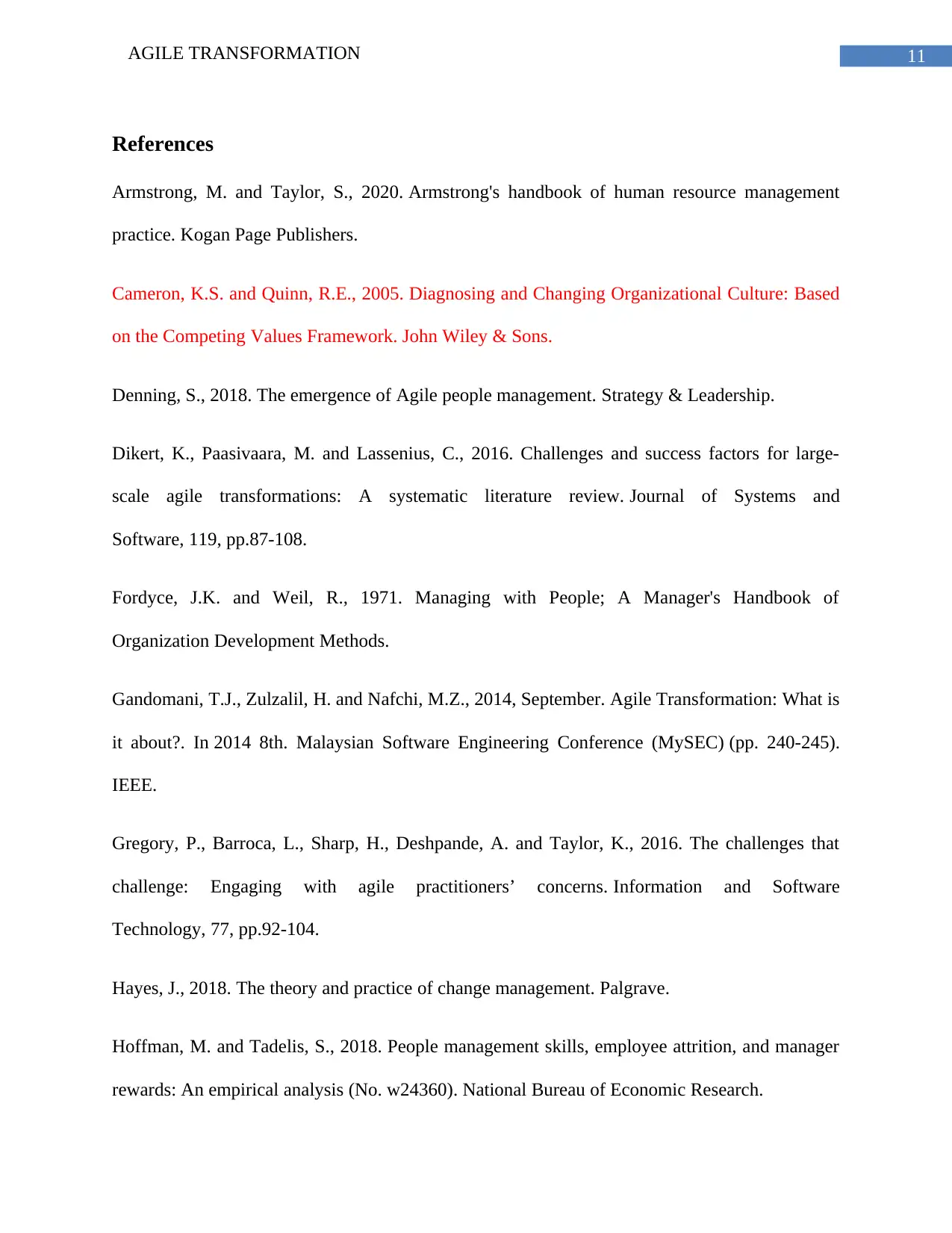
11AGILE TRANSFORMATION
References
Armstrong, M. and Taylor, S., 2020. Armstrong's handbook of human resource management
practice. Kogan Page Publishers.
Cameron, K.S. and Quinn, R.E., 2005. Diagnosing and Changing Organizational Culture: Based
on the Competing Values Framework. John Wiley & Sons.
Denning, S., 2018. The emergence of Agile people management. Strategy & Leadership.
Dikert, K., Paasivaara, M. and Lassenius, C., 2016. Challenges and success factors for large-
scale agile transformations: A systematic literature review. Journal of Systems and
Software, 119, pp.87-108.
Fordyce, J.K. and Weil, R., 1971. Managing with People; A Manager's Handbook of
Organization Development Methods.
Gandomani, T.J., Zulzalil, H. and Nafchi, M.Z., 2014, September. Agile Transformation: What is
it about?. In 2014 8th. Malaysian Software Engineering Conference (MySEC) (pp. 240-245).
IEEE.
Gregory, P., Barroca, L., Sharp, H., Deshpande, A. and Taylor, K., 2016. The challenges that
challenge: Engaging with agile practitioners’ concerns. Information and Software
Technology, 77, pp.92-104.
Hayes, J., 2018. The theory and practice of change management. Palgrave.
Hoffman, M. and Tadelis, S., 2018. People management skills, employee attrition, and manager
rewards: An empirical analysis (No. w24360). National Bureau of Economic Research.
References
Armstrong, M. and Taylor, S., 2020. Armstrong's handbook of human resource management
practice. Kogan Page Publishers.
Cameron, K.S. and Quinn, R.E., 2005. Diagnosing and Changing Organizational Culture: Based
on the Competing Values Framework. John Wiley & Sons.
Denning, S., 2018. The emergence of Agile people management. Strategy & Leadership.
Dikert, K., Paasivaara, M. and Lassenius, C., 2016. Challenges and success factors for large-
scale agile transformations: A systematic literature review. Journal of Systems and
Software, 119, pp.87-108.
Fordyce, J.K. and Weil, R., 1971. Managing with People; A Manager's Handbook of
Organization Development Methods.
Gandomani, T.J., Zulzalil, H. and Nafchi, M.Z., 2014, September. Agile Transformation: What is
it about?. In 2014 8th. Malaysian Software Engineering Conference (MySEC) (pp. 240-245).
IEEE.
Gregory, P., Barroca, L., Sharp, H., Deshpande, A. and Taylor, K., 2016. The challenges that
challenge: Engaging with agile practitioners’ concerns. Information and Software
Technology, 77, pp.92-104.
Hayes, J., 2018. The theory and practice of change management. Palgrave.
Hoffman, M. and Tadelis, S., 2018. People management skills, employee attrition, and manager
rewards: An empirical analysis (No. w24360). National Bureau of Economic Research.
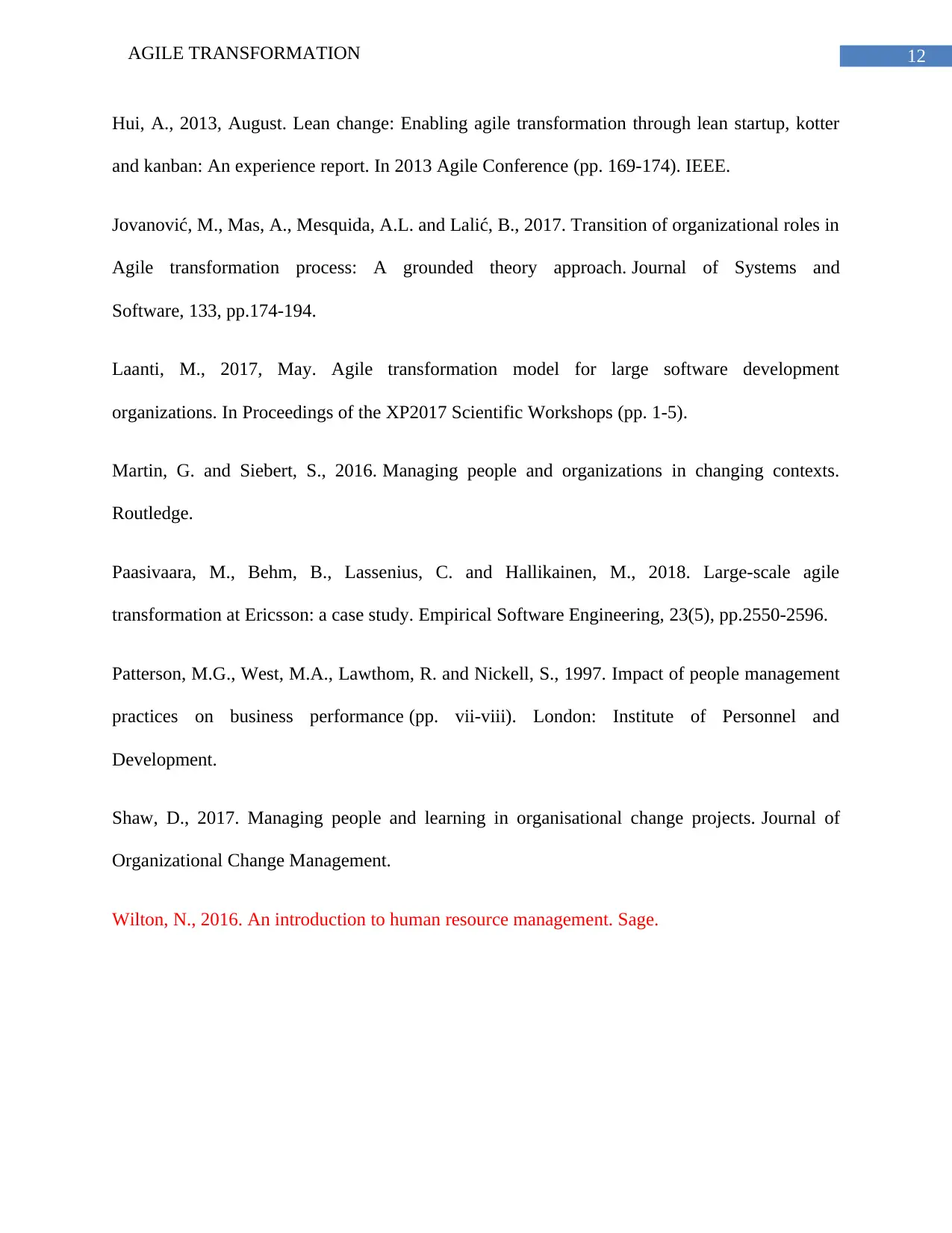
12AGILE TRANSFORMATION
Hui, A., 2013, August. Lean change: Enabling agile transformation through lean startup, kotter
and kanban: An experience report. In 2013 Agile Conference (pp. 169-174). IEEE.
Jovanović, M., Mas, A., Mesquida, A.L. and Lalić, B., 2017. Transition of organizational roles in
Agile transformation process: A grounded theory approach. Journal of Systems and
Software, 133, pp.174-194.
Laanti, M., 2017, May. Agile transformation model for large software development
organizations. In Proceedings of the XP2017 Scientific Workshops (pp. 1-5).
Martin, G. and Siebert, S., 2016. Managing people and organizations in changing contexts.
Routledge.
Paasivaara, M., Behm, B., Lassenius, C. and Hallikainen, M., 2018. Large-scale agile
transformation at Ericsson: a case study. Empirical Software Engineering, 23(5), pp.2550-2596.
Patterson, M.G., West, M.A., Lawthom, R. and Nickell, S., 1997. Impact of people management
practices on business performance (pp. vii-viii). London: Institute of Personnel and
Development.
Shaw, D., 2017. Managing people and learning in organisational change projects. Journal of
Organizational Change Management.
Wilton, N., 2016. An introduction to human resource management. Sage.
Hui, A., 2013, August. Lean change: Enabling agile transformation through lean startup, kotter
and kanban: An experience report. In 2013 Agile Conference (pp. 169-174). IEEE.
Jovanović, M., Mas, A., Mesquida, A.L. and Lalić, B., 2017. Transition of organizational roles in
Agile transformation process: A grounded theory approach. Journal of Systems and
Software, 133, pp.174-194.
Laanti, M., 2017, May. Agile transformation model for large software development
organizations. In Proceedings of the XP2017 Scientific Workshops (pp. 1-5).
Martin, G. and Siebert, S., 2016. Managing people and organizations in changing contexts.
Routledge.
Paasivaara, M., Behm, B., Lassenius, C. and Hallikainen, M., 2018. Large-scale agile
transformation at Ericsson: a case study. Empirical Software Engineering, 23(5), pp.2550-2596.
Patterson, M.G., West, M.A., Lawthom, R. and Nickell, S., 1997. Impact of people management
practices on business performance (pp. vii-viii). London: Institute of Personnel and
Development.
Shaw, D., 2017. Managing people and learning in organisational change projects. Journal of
Organizational Change Management.
Wilton, N., 2016. An introduction to human resource management. Sage.
1 out of 13
Related Documents
Your All-in-One AI-Powered Toolkit for Academic Success.
+13062052269
info@desklib.com
Available 24*7 on WhatsApp / Email
![[object Object]](/_next/static/media/star-bottom.7253800d.svg)
Unlock your academic potential
© 2024 | Zucol Services PVT LTD | All rights reserved.




